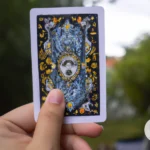Tarot reading is a powerful tool for gaining insight into all aspects of life, and experienced tarot readers know that this practice requires deep introspection and ongoing development. Advanced journal prompts can help readers dive deeper into their practice, explore their biases, and identify patterns in their readings. This article will provide a comprehensive guide to advanced journal prompts for experienced tarot readers, organized into three sections: Reflecting on Your Tarot Practice, Exploring the Cards, and Personal and Spiritual Development. Whether you are a seasoned reader looking to deepen your practice or a curious beginner looking to grow your skills, these prompts will help you gain a deeper understanding of the tarot and yourself.
Section 1: Reflecting on Your Tarot Practice

Deepening your tarot practice involves an ongoing commitment to reflection and introspection. Reflecting on your Tarot Practice is an essential step for experienced readers to sharpen their intuition and gain fresh insights. One way to do this is by revisiting past readings. You can study the cards from previous readings to identify any patterns or themes that are recurring in your readings. Another approach is to explore your biases towards certain cards or interpretations. This allows you to address any preconceived notions or assumptions that may be clouding your readings. Lastly, you can identify emerging patterns in your readings, which can provide useful insights into your life journey or the lives of those around you. Combining these techniques with regular journaling can amplify your reflection process and deepen your practice. You can also find more guidance on tarot journal prompts to help with your reflective practice.
1.1: Revisiting Old Readings
Revisiting old readings is a valuable exercise for experienced tarot readers who want to deepen their understanding of their tarot practice. It can help to uncover patterns in readings, track progress, and gain insight into the accuracy of past readings. Here are some steps to take when revisiting old readings:
- Select a Reading to Revisit: Choose a reading you have done in the past that you felt a connection to or that was particularly meaningful.
- Journal on the Reading: Take time to journal about the reading, reflecting on the cards that appeared and their meanings. Consider the context of the reading, any questions asked, and the overarching themes that emerged.
- Assess Accuracy: Compare your journaling from the time of the reading to what you know now and see if your interpretations still resonate with you. Assess the accuracy of the reading and see if it actually played out how you thought it would.
- Draw Cards Again: Draw the same cards from the reading again and reflect on what they mean to you now. Do they hold the same significance as they did then, or have your interpretations shifted?
- Record Insights: Write down any new insights you gain from revisiting the reading and how it may contribute to your future readings.
Revisiting old readings can provide valuable insights into your tarot practice and personal growth as a reader. It can also help to highlight the importance of using your tarot journal to reflect on past readings. For more guidance on tarot journaling, consider checking out some of the following resources:
- Tarot Journaling Basics: Why and How to Start Journaling
- How to Build Your Own Tarot Card Meanings Journal
- Experiential Journaling for Tarot Readers
- Connecting with Intuition Through Tarot Journaling
- Using Tarot Spreads for Journaling and Self-Discovery
- Tarot Journaling for Personal Growth and Development
1.2: Exploring Your Biases
Exploring your biases is a crucial step in enhancing your tarot practice as an experienced reader. Unconscious biases can hinder your readings and prevent you from providing clear and accurate insights to your clients. To overcome this, take the time to reflect on your preconceived notions and belief systems that may be affecting your interpretations.
One way to explore your biases is to choose a specific tarot card and examine your immediate thoughts and feelings towards it. Are you drawn to or repelled by a particular card? Do you have any negative associations or preconceived notions about certain cards in the deck? Consider how these biases may be impacting your readings and try to challenge them by approaching the card with an open mind and without judgment.
Another helpful exercise is to journal about your personal experiences and how they may be influencing your tarot readings. Our experiences shape our perspectives, and it’s essential to recognize how they can affect our interpretations of the cards. Be honest with yourself and explore how your biases may be affecting the way you read the cards, as this awareness will help you make more accurate and informed interpretations.
As an experienced tarot reader, examining your biases is an ongoing process that requires self-reflection and an openness to challenging your preconceived notions. By doing so, you’ll be able to provide more objective and insightful readings to your clients and improve your overall tarot practice.
1.3: Identifying Patterns in Your Readings
As an experienced tarot reader, it is essential to identify patterns in your readings to gain a deeper understanding of the themes and messages that are emerging from the cards. Keep in mind that the patterns may not always be obvious, and it may require multiple readings to identify them accurately. Here are some steps to help you with identifying patterns in your readings:
1. Take Notes: Taking notes during your tarot reading session can help identify patterns as you start to see common themes or cards emerging. Reviewing these notes can help you make connections between seemingly unrelated cards or situations.
2. Group Similar Cards: Grouping similar cards can help identify patterns and themes in your readings. Make a list of the cards that are commonly drawn together, or cards that seem to have similar meanings. For example, if you keep drawing the Ace of Cups and the Page of Cups, it could indicate a new emotional experience or a new relationship.
3. Look for Repeating Themes: Look for repeating themes, symbols, or messages across multiple readings. This may help you identify patterns that are unique to your readings. For instance, if you keep seeing cards related to travel or adventure, it could imply that your life is about to take you on a new adventure.
4. Pay Attention to Card Placement: Card placement can also help identify patterns. For example, if you keep drawing the same card in a particular position, it may indicate that you need to focus on that area of your life or that the energy represented by the card is particularly strong.
5. Use Tarot Spreads: Lastly, using tarot spreads can help identify patterns in a more structured manner. A spread like the Celtic Cross can help you see connections between the cards and explore their meanings in a more comprehensive way.
Remember, while identifying patterns in your readings is essential, don’t get too hung up on them. Each reading is unique, and it’s crucial to approach each session with an open mind and let the cards guide you. However, identifying patterns in your readings can help you gain a deeper understanding of both your tarot practice and yourself.
Section 2: Exploring the Cards
In tarot, each card holds multitudes of meanings and symbolism, making them a fascinating tool for exploration and discovery. Section 2: Exploring the Cards delves deeper into understanding the cards and their associations. This section covers the significance of Reversals and Shadow Work, allowing you to examine the darker attributes of the cards and the psyche. It also explores Elemental Associations, which can aid in comprehending the fundamental structures of the tarot and how it relates to the natural world. In addition, Astrological Correspondences gives insight into the connections between the cards and astrology. By learning about and reflecting on these topics, experienced tarot readers can expand their knowledge and interpretation of the cards.
2.1: Reversals and Shadow Work
One of the most debated topics among tarot readers is the use of reversed cards in readings. While some readers believe that reversals can add depth and nuance to a reading, others prefer to stick with upright cards only. Whichever camp you fall into, it can be useful to explore the shadow side of each card and how it might manifest in a reading.
Reversals: Reversals offer an opportunity to delve deeper into the shadow aspects of a card. When a card appears reversed, it can suggest that the energy of that card is blocked, distorted, or in some way turned inward. This can indicate an area of growth or healing for the querent, and it can also point to areas of self-exploration for the reader.
To get started with reversed cards, try shuffling your deck and pulling out one card at a time, noting whether each card is upright or reversed. Reflect on the meaning of each card and how it might change when it appears reversed. As you become more comfortable with reversed cards, you can incorporate them into your readings and use them to add depth and texture to your interpretations.
Shadow Work: In addition to exploring reversed cards, tarot readers can also engage in shadow work as a way of uncovering unacknowledged or hidden aspects of the self. Shadow work involves examining the parts of ourselves that we may have repressed or rejected, and integrating them into our consciousness in order to achieve greater wholeness and self-awareness.
To incorporate shadow work into your tarot practice, start by selecting a card that represents an aspect of yourself that you struggle with or resist. Spend some time reflecting on what that card means to you and how it might be reflecting a part of yourself that you have been avoiding. Consider journaling about your thoughts and insights, or talking with a trusted friend or therapist about what comes up for you during this process.
Using reversals and incorporating shadow work into your tarot practice can be powerful tools for personal growth and self-exploration. By exploring the shadow aspects of our cards and ourselves, we can gain greater insight into our true nature and unlock our full potential.
2.2: Elemental Associations
When it comes to deeply connecting with tarot readings, understanding the elemental associations of each card can be incredibly illuminating. Cards can be classified as earth, air, fire, or water, with each element lending its own unique energies to the reading.
Earth: The earth element is associated with the physical realm and all things tangible. When a tarot card is classified as earth, it speaks to concepts such as stability, grounding, and practicality. Examples of earth cards include the Ace of Pentacles and the Ten of Pentacles.
Air: The air element is linked to the realm of thought and intellect. Air cards are often associated with communication, decision-making, and mental clarity. Examples of air cards include the Ace of Swords and the Queen of Swords.
Fire: The fiery element is all about passion, creativity, and inspiration. Cards classified as fire are often associated with transformation, courage, and bold action. Examples of fire cards include the Ace of Wands and the Knight of Wands.
Water: The water element is connected to emotions, intuition, and the subconscious. Cards classified as water often speak to deep feelings, creative expression, and spiritual growth. Examples of water cards include the Ace of Cups and the Queen of Cups.
By exploring the elemental associations of tarot cards in your journal practice, you can deepen your understanding of the cards and unlock new insights for your readings. Consider drawing a grid with earth, air, fire, and water categories and filling in cards as you journal about them. You may start to notice patterns or themes within each element that shed new light on the meanings of the cards.
2.3: Astrological Correspondences
Astrological correspondences offer a fascinating way for tarot readers to deepen their understanding of the cards. Each card in the tarot deck is associated with a particular planet, zodiac sign, or both. By exploring these associations, experienced tarot readers can gain a deeper understanding of the energy and symbolism inherent in each card.
To start exploring astrological correspondences, tarot readers can begin by studying the Major Arcana cards and their corresponding planetary or zodiac associations. Some examples of these associations include:
– The Magician: Mercury
– The Empress: Venus
– The Emperor: Aries
– The Hierophant: Taurus
– The Lovers: Gemini
– The Chariot: Cancer
– Strength: Leo
– The Hermit: Virgo
– Justice: Libra
– Death: Scorpio
– The Wheel of Fortune: Jupiter
– The Hanged Man: Neptune
– The Devil: Capricorn
– The Tower: Mars
– The Star: Aquarius
– The Moon: Pisces
By paying attention to the astrological correspondences of each card, tarot readers can begin to develop a deeper understanding of the archetypes and energies represented by the cards.
One way to incorporate astrological correspondences into your tarot practice is to use them as a way to establish connections between cards in a spread. For example, if you pull The Magician and The Chariot in a spread, you might interpret this as a message to harness your intellectual power (associated with Mercury) to achieve your goals (associated with Cancer).
Another way to use astrological correspondences is to incorporate them into meditative or ritual practices. For example, you might perform a ritual on the night of a full moon to honor the energies associated with The High Priestess (associated with the Moon).
By exploring astrological correspondences in the tarot, experienced readers can deepen their understanding of the cards and gain new insights into their readings. The key is to approach this practice with curiosity and an open mind, allowing the correspondences to guide your intuition and enhance your spiritual journey.
Section 3: Personal and Spiritual Development
This section is focused on how experienced tarot readers can
Subscribe to Our Newsletter
Sign up to receive the latest news and updates.
3.1: Identifying Limiting Beliefs
Identifying and working through our limiting beliefs can be a powerful tool for personal and spiritual growth. Limiting beliefs are negative thoughts or beliefs we hold about ourselves, others, or the world that hold us back from achieving our full potential. These limiting beliefs can become ingrained in our psyche and impact our behaviors, thoughts, and emotions. By identifying and challenging these beliefs, we can shift our mindset and break free from these self-imposed limitations.
Here are some advanced journal prompts for experienced tarot readers to help identify and work through limiting beliefs:
| Prompt | Description |
|---|---|
| 1. What do I believe about myself that is holding me back? | Identify any negative self-talk or beliefs you may have about yourself, such as “I’m not good enough” or “I don’t deserve success.” Write them down, and then challenge these beliefs by writing out evidence that contradicts them. For example, if you wrote “I’m not good enough,” write out times when you have succeeded or received positive feedback. |
| 2. What do I believe about others that is holding me back? | Think about any negative beliefs you hold about others, such as “People are untrustworthy” or “Nobody cares about me.” Write them down, and then challenge these beliefs by considering times when someone has been trustworthy or showed they cared about you. |
| 3. What do I believe about the world that is holding me back? | Consider any negative beliefs you may hold about the world, such as “Everything is out of my control” or “The world is a scary place.” Write them down, and then challenge these beliefs by looking for evidence to the contrary. Consider times when you have felt in control or when the world has shown you beauty and kindness. |
| 4. How can I reframe my limiting beliefs? | After identifying your limiting beliefs, consider how you can reframe them in a more positive light. For example, instead of “I’m not good enough,” reframe it as “I am capable of growth and learning.” Create affirmations or mantras based on these positive reframes and repeat them to yourself daily. |
Remember, working through limiting beliefs takes time and practice. Don’t expect to shift your mindset overnight, but by regularly using these prompts, you can begin to identify and challenge the beliefs holding you back and move towards a more positive and empowered mindset.
3.2: Manifestation and the Law of Attraction
Many tarot readers believe in the power of manifestation and the law of attraction. This involves the idea that we can attract what we want in life, to manifest our desires through our thoughts and actions. Tarot can be a powerful tool for working with manifestation and attraction.
To explore this aspect of your tarot practice, consider the following advanced journal prompts:
| Prompt | Description |
|---|---|
| 1. Manifestation Spread | Create a spread designed specifically to help you manifest your desires. This might involve cards that represent your current state, what you want to manifest, and the steps you need to take to get there. |
| 2. Law of Attraction Reflection | Reflect on how you can apply the law of attraction in your tarot practice. Consider questions such as: How can you use the cards to focus on your desires? What messages are the cards sending you about what you need to do to make your desires a reality? |
| 3. Identifying Blocks to Manifestation | Use tarot to explore any limiting beliefs or blocks that are preventing you from manifesting what you desire. Pull cards to represent these blocks or beliefs and explore what they might mean and how you can work through them. |
| 4. Abundance Journaling | Start a journal focused on abundance and prosperity. Pull a card each day and reflect on how it relates to your current abundance mindset. Explore any patterns or challenges that come up and brainstorm actions you can take to shift your mindset in a more positive direction. |
Working with manifestation and the law of attraction can be a powerful way to bring positivity and abundance into your life. By using tarot to explore these concepts, you can gain new insights and perspectives on your desires and how to make them a reality.
3.3: Setting Intentions for Personal Growth.
One of the most powerful ways to use tarot for personal and spiritual development is by setting intentions for personal growth. When we set intentions, we declare our desires to the universe and create a focused energy that can help us manifest our goals and aspirations. Here are some advanced journal prompts for experienced tarot readers that can help you set powerful intentions for your personal growth:
1. Identify your most significant personal growth areas: Take some time to reflect on your life and identify the areas where you want to grow the most. It could be emotional healing, financial abundance, better relationships, or anything else that resonates with you.
2. Clarify your intentions: Once you identify your growth areas, it’s time to clarify your intentions. Write down your goals in a clear and concise manner. Make sure you focus on what you want to achieve, not what you don’t want.
3. Use tarot to gain deeper insights: Shuffle your tarot deck and pull a card or multiple cards that represent your intentions. Reflect on the symbolism in these cards and how they relate to your growth areas.
4. Create a plan of action: Once you have a clear understanding of your intentions, create a plan of action for achieving your goals. Write down the steps you need to take, the resources you need, and the timeframe for achieving your goals.
5. Track your progress: Regularly track your progress towards your intentions. Use your tarot cards to gain insights into what’s working and what’s not. Adjust your plan accordingly and keep working towards your goals.
Remember, setting intentions is a powerful tool that can help you create the life you desire. With the help of tarot and these advanced journal prompts, you can take your personal growth to the next level.
Conclusion
Conclusion:
There are a variety of advanced journal prompts that experienced tarot readers can use to enhance their practice. Reflecting on past readings, exploring biases, and identifying patterns in readings can help readers gain insight into their personal approach to tarot. Exploring the individual cards through reversals, elemental associations, and astrological correspondences can deepen one’s understanding of the deck. Finally, personal and spiritual development is a key aspect of tarot reading, and identifying limiting beliefs, working with manifestation and the law of attraction, and setting intentions for growth can help readers bring their best selves to their practice.
By regularly journaling on these prompts, tarot readers can deepen their understanding of the cards, their own personal approach to tarot, and their spiritual journey. Remember to approach your journaling practice with an open mind and a willingness to explore new insights. With these advanced prompts, you’ll be able to take your practice to the next level.
Frequently Asked Questions
1. How often should I practice tarot to be considered an experienced tarot reader?
There is no set requirement for how often you should practice tarot to become an experienced tarot reader. Many readers find that practicing daily or weekly helps them hone their skills over time.
2. Can I use advanced journal prompts for tarot readings on clients?
It is important to get permission from clients before using advanced journal prompts during tarot readings. Not all clients may feel comfortable with this type of introspection and it is important to respect their boundaries.
3. What is shadow work and how can it be utilized in an advanced tarot practice?
Shadow work involves reflecting on and acknowledging the parts of oneself that are often repressed or denied. Utilizing this in tarot can involve exploring the darker aspects of the cards or examining personal biases and blind spots during the reading process.
4. How can I incorporate astrology into my tarot practice?
Astrology can be used to deepen the meaning of certain cards or to identify patterns in a reading through the use of astrological correspondences. Utilizing birth charts can also allow for a more personalized reading experience.
5. Can advanced journal prompts be used for tarot readings online?
Yes, advanced journal prompts can be used for tarot readings online. It is important to make sure the person receiving the reading is comfortable with the prompts and to provide clear instructions on how to use them in the online format.
6. How can identifying limiting beliefs improve my tarot practice?
Identifying limiting beliefs can help prevent them from influencing the reading process and allow for a more objective approach. This can result in a more accurate and helpful reading experience for both the reader and the client.
7. Can advanced journal prompts be used in a group setting during a tarot practice session?
Yes, advanced journal prompts can be utilized in a group setting during a tarot practice session. This can allow for a deeper exploration of the cards and encourage personal growth among the group members.
8. How can the law of attraction be incorporated into my tarot practice?
The law of attraction can be utilized in tarot by focusing on positive intentions and manifesting desired outcomes during the reading process. This approach can help clients feel empowered and may result in more uplifting and beneficial readings.
9. Can advanced journal prompts be used during a tarot meditation practice?
Yes, advanced journal prompts can be utilized during a tarot meditation practice. This can allow for a deeper exploration of the cards and encourage personal growth and self-reflection during meditation.
10. Is it necessary to use advanced journal prompts in an advanced tarot practice?
No, it is not necessary to use advanced journal prompts in an advanced tarot practice. These prompts can provide a helpful tool for self-reflection and personal growth, but they are not essential for becoming an experienced tarot reader.










